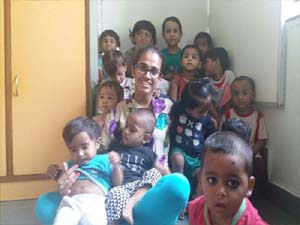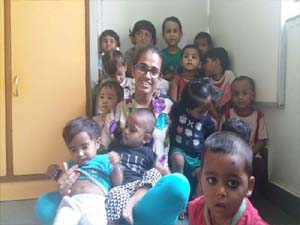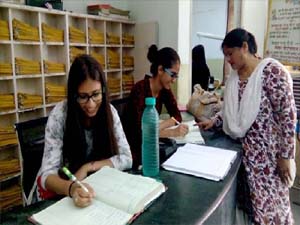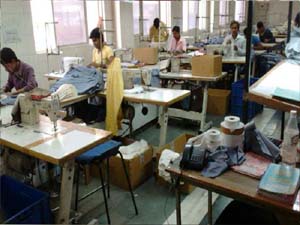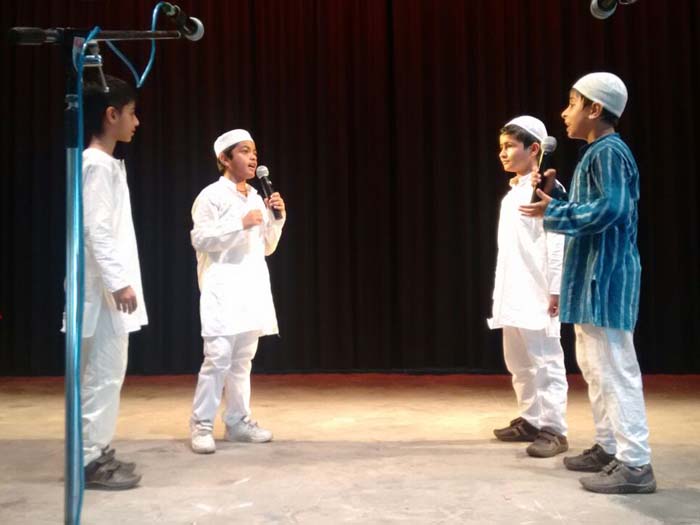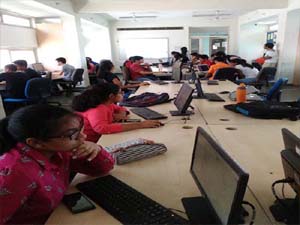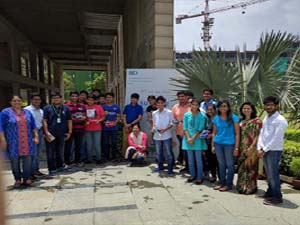2016/ Summer Internships for class 11 at Moolchand Medcity, Hope Foundation, Pearl Academy, DS ( Catch ) group of companies and IIIT-Delhi.
Class 11 Summer Internship at Moolchand Medcity for Psychology students
Five students of class XI- Arunima Palit, Suraj, Lakshay and Vanshika were accorded an opportunity to explore the world of psychology which lies outside the books, during a six day summer internship programme starting June 1st , 2016 at Moolchand Hospital.
On the first day, we were accompanied by our psychology teacher, Ms. Sukhmeen Cheema to meet Dr. Jitendra Nagpal, Senior Consultant, Psychiatry and Child Health Psychology. We also met some interns who were bachelors’ and masters’ students at Delhi University.
Dr Nagpal briefed us about all the activities we would be undertaking in the following days.
For the next few days we had sessions with Dr. Nagpal and Clinical Psychologist, Ms. Aastha Sharma about various psychological disorders like:
· Clinical features of Depression
· Cyberbullying through blogs and instant messaging
· Adolescent issues like substance abuse
· Obsessive Compulsive Disorder and other anxiety disorders
· Learning disorders like Dyslexia, Dyscalculia etc
These interactive sessions were supplemented with case studies that brought a greater understanding of these concepts. For instance, a lady washes her hands repeatedly as she thinks they get dirty each time she uses them for her chores etc. but when a normal person looks at her hands, they look perfectly clean. Even if she touches a doorknob she gets obsessive about her hands being dirty and is driven to perform the compulsive act of washing repeatedly. The cause of this kind of behaviour is deep-rooted anxiety.
In the end we were asked to prepare projects based on our understanding on cyber-bullying. We submitted the projects after the requisite research and these were much appreciated by the seniors.
Interactions with seniors in the field gave us first hand insight into the prospects in this field,
ranging from clinical and counselling psychology to organisational psychology and how psychology is becoming one of the most sought-after courses in India owing to a huge amount of awareness about mental health in India.
We chose this internship because of our interest in the subject and we can’t stop thanking School for exposing us to such a vast treasure of experiential knowledge available from the experts themselves.
Class 11 Summer Internship : The Hope Project ( NGO)
In the heart of the Hazrat Nizamuddin Basti lies the Hope Project, a charitable organisation that upholds the teachings of the Sufi saints. Its aim is to enable the poor to help themselves. The various programmes launched by the organisation help to counter the problems faced by people living in this basti. It is driven by the spirit to serve humanity, whilst showing respect to all religions. It strives to provide the poor with resources and opportunities to enable them to realise their potentials, determine their futures and become responsible members of society.
4 students, Bhavika Sharma, Sakshi Singh, Arushi Grover and Yasha Jain of class XI volunteered to work at The Hope Project for a week from 23 May to 3 June 2016, as their summer internship. During this period, they were placed in different departments of the organisation, namely, healthcare, education and the crèche. They worked by turn in each of these departments during the internship so that each student could get a feel of every department. They were accompanied by the School counsellor, Ms. Enakshi Rai on the first day of their internship.
On the first day itself, coordinator, Mr. Masoom oriented the students about the vision and mission of the organisation along with its working. The project was founded in 1975 by a Sufi preacher, Pir Vilayat Khan, who was moved by the immense poverty of the people living near the mausoleum of his father and he envisioned a programme to arm the poor to help themselves.
The Hope Project currently runs community health centres, mobile medical units, education centres, a thrift and credit programme, baking and catering courses, vocational courses and income generation courses for the entire family.
The students were divided in two groups, one to work in the healthcare department and the other to work in the crèche. The healthcare department serves the medical needs of the people and aims to provide a comprehensive health programme that offers treatment, diagnosis and medication. The underprivileged people of the Nizamuddin Basti, Sarai Kale Khan, Srinivaspuri and Nehru Nagar regularly visit the healthcare department for their medical check-ups.The students offered their services in the OPD and the homeopathy department. They worked under the supervision of Dr. Luna Ajmali and their primary role was to handover medicines prescribed by the doctor to the patients. They also worked at the reception and maintained a record of the diagnosis and treatment of patients for future referrals, took care of finances and issued new booklets.
Working at the crèche was also a very valuable experience for the students. The purpose of the crèche was to meet the needs of the mothers in the Basti who need to leave their children in a safe environment when they go for their daily work. The crèche had a supervisor and a coordinator with 3 trained support staff to help the children. It provided a healthy and stimulating environment for the growth of the children. Our young interns organised various activities to help the children in their overall development. Special craft classes were held for the children who were in the age group of 5 to 8. They were taught to make paper bags and pen stands using waste paper. The children of the crèche were engaged in different games so that they learn t to work in teams. The crèche is more than a just a day care facility as it grooms the children to secure a bright future.
The interns regularly had interactive sessions with the children studying in the education centres. Usually a topic or a subject of difficulty would be brought up for discussion. They assisted in teaching fundamental Math and conversing in English. It was here that they made many friends!
It was indeed an excellent learning experience as it provided a platform to learn community service.
Bhavika Sharma.
Class 11 Summer Internship: DS Group ( Catch Factories)
Four students of class XI of underwent an internship programme with the DS Group from 2nd to 4th June 2016. The students Vrvyas Gupta, Faizan Saifi, Gaurav Prasad and Bedanto Sen, accompanied by their teacher Ms. Veena Ajay Kumar, spent time at three factories of the DS Group.
The team started their internship with a visit to PravekKalp, an ayurvedic unit where they were given a warm welcome by the manager, Mr Hoshiar Singh. Mr. Singh took the students around and gave them a complete introduction of facility. The company has a unique variety of products ranging from herbal oils, herbal slimming tea and anti-allergic medicines, etc. A doctor on site explained how the different medicines and oils were prepared. He told them that great care was taken while processing the products to neutralise the effects of pollution on herbs and plants and extract their natural benefits to the maximum.
A visit to the Catch Factory was also arranged on the same day where students got an opportunity to interact with factory workers. They were shown the different stages of production, from the selection of spices, to their grinding and packaging. Catch endeavours to use the best herbs and plants in their products. This ensures consistent quality and a therapeutic efficacy of the products, thereby providing guaranteed relief to users. A major U.S.P. of these products is that they are free from any form of microbial contamination or pollution. They use the Low Temperature Grinding (LTG) technology which prevents the evaporation of volatile and delicate oils from the spices. Catch Spices thus, retain the original aroma and wholesome flavour of authentic spices.
The complete product assortment comprises of a variety of salt and pepper sprinklers and a diverse range of whole, ground and blended spices. Catch Spices are packed in food grade metal-lined cartons, flexible laminates and convenient composite cans, available in a variety of pack sizes. It was interesting to learn what goes into the making of a herbal successful product!
On the second day of the internship, we were taken to the packaging unit of Catch. We were familiarised with the process of packaging. He explained that packing, is customised for the product, depending on its particular characteristics. For example, in the case of chips, they provide three layers of packaging, with aluminium being the innermost layer to ensure freshness and crispiness.
We saw different packaging machines. In one case, card board was being fitted onto a roller to be moulded into a cylindrical container, while on another machine caps were being moulded for containers.
After an interesting and interactive session at the packaging unit we were taken to the Funk factory, which is the clothing brand of the DS Group. The Noida unit of Funk Brand specialises in cotton trousers, shirts and tee shirts. We were told that as a marketing strategy, Funk products are sold only online and not in the open market.
On the third day we went to the Rajnigandha Silver Pearls’ Unit. Rajnigandha Pearls are made from handpicked green cardamom and coated with pure silver leaf. Green cardamom is very aromatic with a very wide range of uses. The plant has underground stems with leafy roots, large white or pale green leaves, pale green fruits and black seeds. The spice has a very warm aroma and fresh taste which it can retain for a very long time. It helps in countering acidity and is considered good for asthma patients. It can also increase appetite and be used as a mouth freshener. Green cardamom is blended with saffron to elevate the mouth freshening experience. We saw how zipped sachets were prepared and how the product was packed into them.
At the end of our three day internship, we carried back an experience which was invaluable.
Mohd.Faizaan Saifi.
Class 11 Summer Internship: Moolchand Medcity
3 of our Biology students, Shubhangi Arora, Ishita Dhanda and Bhumika Narang of class XI of attended a two-day internship programme on 3rd and 4th June 2016 at the Moolchand Hospital. The objective of the internship was to familiarise students with equipment used in hospitals and learn how to write a patient’s report.
On the first day, the students attended a seminar on how to develop a patient’s case study. Dr. Astha Saxena, senior counselor at Moolchand, gave them a brief introduction on the significance of a case study and then how to write it. Students were also given a few case studies to read. Thereafter, Dr. Manju Madan took the students on a short tour around the various departments. She showed them a CT-Scan machine and explained its functioning. Deepika Chauhan, senior intern at Moolchand, also spoke to the students about Bipolar Disorder. She spoke about the different categories of this disorder, its symptoms and treatment.
The next day, Dr. Manju Madan showed the group an MRI machine and explained its functioning. The doctors conducting the MRI spoke about how this machine enabled doctors to accurately diagnose diseases. The students stayed in the room for an hour until the MRI scan of a patient had been completed. They were able to view the entire procedure and understand the various precautions one must take while using this machine.
The internship programme proved very useful for our students as it helped them gain first-hand information and familiarised them with hospital equipment. Such visits will only help to enlighten them more.
Ms. Purvi Mehta.
Class 11 Summer Internship: Pearl Academy ( Fashion)
Ten students of classes XI and XII attended a 6 day workshop at the Pearl Academy, Noida from 6th to 11th June 2016. The students were able to to explore, first-hand, the various areas of fashion like styling, communication, business and visual merchandising during this brief stint at the institute.
On the first day, the focus of the programme was architecture and interior design. Architecture deals with the exterior shell while interior design deals with the inside. We were shown how spaces, big and small are conceived to be built and decorated. We were asked to create a few rough models from wooden blocks. The models had to replicate the outside of a structure. It had to be something unique and different. This activity had us don our thinking caps and stretch our imaginations! Later, we also created models using materials such as thermocol, threads, cardboard and toothpicks. Each individual model was then combined with four other models to create a unique formation.
The second day was equally exciting as it dealt with the designing of garments. We had to design five dresses in a span of one hour! The texture of the outfits had to be the same as we were provided with only one fabric, a sari. It was a challenge to create all the dresses from only one fabric. Once the designing was done, we had to actually make the outfits! We created a crop-top, shrug, mini skirt, dress, etc. All of this was done with the help of a fashion stencil which was provided to us by the academy. Later, a few of us even donned these dresses for an impromptu fashion show!
On the third day, we had an interactive session on fashion styling. The students had many questions to ask and it was quite engaging. The second half of the day was spent styling our own garments. We did this by cutting up old T-shirts into various shapes and styles. This demanded a lot of ingenuity and imagination from our end but it all ended well. This was followed by a photo shoot where students also got to model what they had created!
The fourth day started with a business workshop where we were spoken to about visual merchandising. We were shown the selling techniques of different brands and how companies deal with competition from other brands. We were also exposed to things like private labels, national labels, e-commerce, startup, retail etc. Personally, it was the most interesting part of the 6-day internship. After the session, we were asked to design a window display. Students were divided into groups of 4. Each group assumed a different style like punk, roadster or classy etc. Each group also had to assume a particular brand through which they had to showcase their presentations. The day ended well with a ‘selfie session’ with several staff members from Pearl.
The next day, we visited a garment industry where we studied the garment-making process. The various kinds of machines and skills used to produce garments were observed. The kind of detailing required to develop a single garment was a great eye-opener!
The last day was very engaging. The day started with a hair and makeup workshop. Later, a few of us were made to dress up in cocktail dresses, while the rest had to do up the hair and makeup to suit the dresses. Some budding artists amongst us came up with fancy floral designs around the eyes, nude lips with a bold eye look, peacock eyes with dark lips and much more! W e had a ramp walk in which our models had to showcase the makeup and hair styles created by the other group members. The ramp walk was followed by a small dance party and refreshments – a perfect end to a wholesome programme!
The experience was very useful as it provided us with a generous glimpse into the fashion world. I’d like to thank our School for providing us with this opportunity and look forward to other such experiences in the future.
Devangini Aggarwal (Class XI).
Class 11 Summer Internship : IIIT-Delhi ( Computer technology)
The Indraprastha Institute of Information Technology, Delhi (IIIT-Delhi) organised a Computer Science Internship Programme between 30th May and 3rd June 2016 at the institute. 20 students of our School attended the programme which comprised of 6 sessions as below:
• Robot Making
• Wireless Networking
• App Designing
• Geographic Information System (GIS)
• Arduino
• Computer Data Protection and Secure Communication
Both power point presentations and practical demonstrations were given to impart training to the students.
Day 1 (Robot Making)
The first session was held on Monday 30th May, 2016. Students were accompanied by their teachers to the venue. Here, they were taught how to create a robot. Essential parts of a robot were shown to them. Their guide, a student of the institute showed the students the several sensors used in robots. One such sensor was the Passive Infrared Sensor. The students also got a chance to created a robot using this sensor and even learnt to programme it. The robot once equipped with the sensor is able to sense any obstacle in its way and move away. Following the tutorial, the students were divided into groups of 4. Each group created their own robot and programmed it the way they wanted it to react when it sensed an obstacle. Each of the groups also programmed their robots to follow a black line on a white canvas. Finally, when all the robots were ready, the groups raced their robots against each other on the canvas. The group whose robot completed the track in the shortest time won the race.
Day 2 (Wireless Networking)
The second session was held on Tuesday 31st May, 2016. Students were asked to reach the venue on their own. On day 2, they learned about the working of wireless networks and devices. They were taught how to send and receive data without the use of wires through the Wireless Fidelity (Wi-Fi) system. They were also taught how to connect to a Wireless Local Area Network (WLAN), through a Wi-Fi router, so that their device could connect to the internet. They learned about the ethernet cable and how it is used to connect a PC to the internet. The resource person also taught the students how to achieve strong Wi-Fi signals and how to secure a WLAN using a password. They learned about the different types of cables and their speed of transferring data. Lastly, the students were taken to a lab where it was demonstrated practically how a device sends and receives data.
Day 3 (App Designing)
The third session was held on Wednesday 1st June, 2016. On day 3, students learnt about App Designing. The resource person was one Dr. Arun Mehta, professor at IIIT. He taught the students how to design android apps. The students were divided into groups of 2 to design these apps. They were given PCs equipped with software using which they could design the apps. They designed apps to convert text to speech, make a rolling ball that they could put through a hole, doodle on the screen, etc. They ran their apps on their smartphones and made necessary changes. Dr. Mehta invited each child separately to explain a particular function in the software better. He also helped each to clarify all doubts. At the end, he taught the students how they could publish their apps on Google Play Store and convert their apps to APKs.
Day 4 (GIS and Arduino)
The fourth and fifth sessions were held on Thursday 2nd June, 2016. One of the sessions was on the Geographic Information System (GIS) and the other was on Arduino. In the first session, the students learned about the Global Positioning System (GPS) and how to locate a place with given coordinates using Google Maps. The resource person also taught the students how to generate a driving route, a cycling route or a walking route from one place to another. They learned to measure the road distance from one place to another by simply placing the latitudes and longitudes on a given HTML code. They also learned to publish maps and waypoints independently on Google Maps.
In the second session, the students learned about the Arduino board. This is a device which allows the user to give it a command. The resource person divided the students into groups of 2 and provided each group with an Arduino board, LEDs and wires. He showed the students how to generate a code on the Arduino software to get the LED lights to blink. He also showed them how to generate a code so that 3 LEDs connected to an Arduino board could be made to blink like traffic lights. Later, he also connected an ultrasonic sensor to the Arduino board and showed students how the LED glows when the ultrasonic sensor senses an object in its way. The group also learned to set the range (sensitivity) of the ultrasonic sensor. At the end, the resource person gave students examples of where all an Arduino board could be used.
Day 5 (Computer Data Protection)
The sixth session was held on Friday 3rd June, 2016 on Computer Data Protection and Secure Communication by a professor at IIIT. He gave the students a talk on how information sent to a person could be made secure. He also told them how to compress a file and to what limit it can
be compressed. He showed students the method used by hackers to intercept data being sent to people. Later, he conducted an activity to extract a message from a given pattern. Finally, he divided the students into 3 groups. One group was supposed to generate a message and send it to the third group, the other was to make a suitable pattern of the message and try to decode it and the third group was to collect the data, decode the pattern and extract the message from that pattern.
The second group was not able to decode the message but the third group did. The trick was that the third group had some specific points marked on the pattern, which the second group didn’t have. This showed how a person can secure data so that it could only be read by the person to whom the data is being sent. At the end, the professor gave the students names of books that they could refer to for more information on the subject.
The instructors and student coordinators at IIIT- Delhi contributed extensively to the success of the workshop. We truly appreciate IIIT-Delhi for providing our students with invaluable insights into the application of different cutting edge technologies and for access to their lab facilities. Our students truly benefitted from the programme.
Ms. Nitu Pandey.





